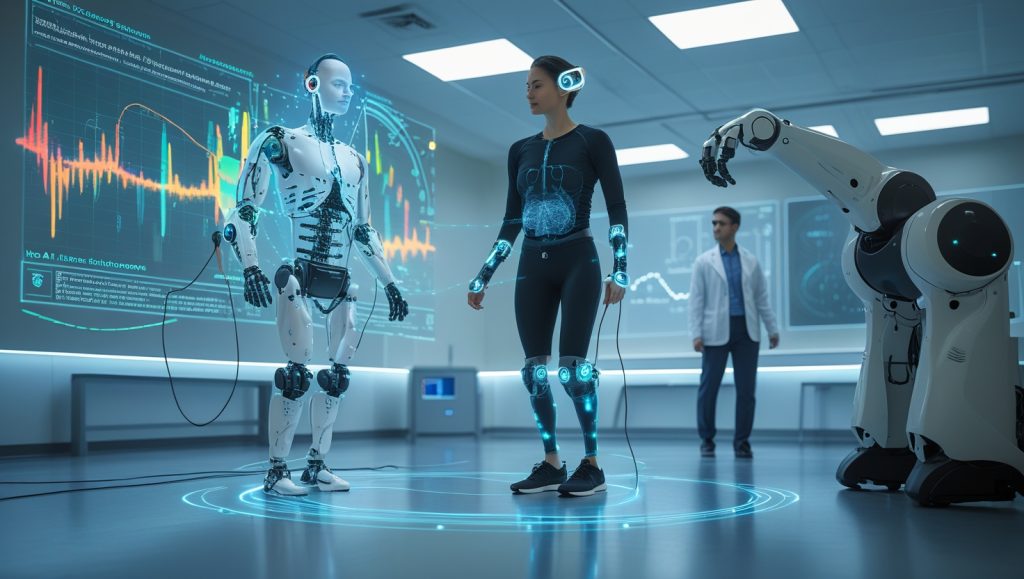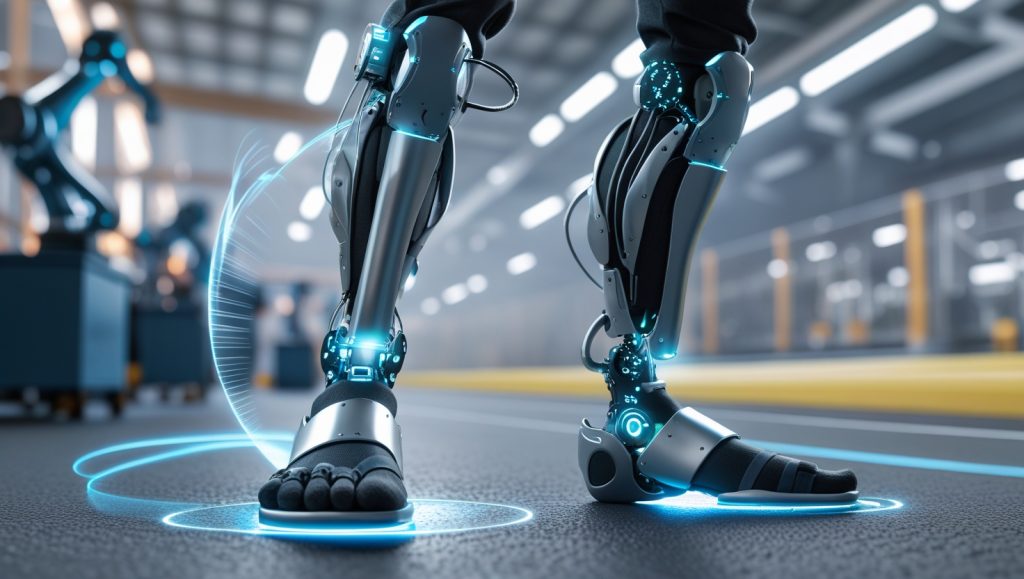Neural Interface-Controlled Exoskeletons: When Thoughts Become Motion
Imagine waking up one day unable to move your legs. For 72-year-old Maria Gonzalez, this nightmare became reality after a stroke in 2021. Four years later, in 2025, she took her first unassisted steps using a neural interface-controlled exoskeleton—a device that translated her brain signals into movement. “It felt like my body remembered how to walk,” she recalls. Maria’s story is no longer science fiction. Across labs and clinics worldwide, this fusion of neuroscience and robotics is rewriting the rules of paralysis recovery. But how does it work? Who benefits? And why does this technology matter now more than ever in 2025?
The Science of Mind-Controlled Mobility: Breaking Down the Basics
What Makes Neural Interface-Controlled Exoskeletons Unique?
Traditional exoskeletons rely on joysticks or pre-programmed motions, offering limited agency to users. Neural interface-controlled exoskeletons, however, harness brain-computer interfaces (BCIs) to decode intent directly from neural signals. This allows paralyzed individuals to control robotic limbs as naturally as they once moved their own bodies.
The Three Pillars of Functionality
- Signal Capture: Electrodes (non-invasive EEG caps or implanted arrays) detect electrical impulses from the brain or peripheral nerves.
- Signal Translation: Machine learning algorithms interpret neural patterns into actionable commands (e.g., “walk forward” or “grasp cup”).
- Mechanical Execution: Motors and sensors in the exoskeleton replicate human biomechanics with millimeter precision.
A landmark 2023 Nature study demonstrated that BCIs could decode movement intent with 94% accuracy in spinal cord injury (SCI) patients. By early 2025, teams at the Swiss Federal Institute of Technology reduced signal latency to 150 milliseconds—matching the speed of natural neural transmission.
3 Innovations Accelerating the Neuro-Exoskeleton Revolution

1. Non-Invasive BCIs: Democratizing Access
Early neural interfaces required invasive brain implants, limiting their use to clinical trials. Today, in 2025, companies like Neurable and OpenBCI have pioneered EEG-based headsets that capture high-fidelity signals through the scalp.
Real-World Impact: In 2024, Johns Hopkins University partnered with BrainGate to trial a neural interface-controlled exoskeleton with quadriplegic patients. Participants achieved 89% accuracy in controlling limb movements during walking tasks—a 30% improvement over earlier models.
The rise of non-invasive neural interface-controlled exoskeletons marks a pivotal shift in accessibility. Unlike invasive systems, which carry surgical risks and high costs, EEG-based solutions are portable and user-friendly, making them viable for home use. For example, a neural interface-controlled exoskeleton developed by Neurable allows users to calibrate the system in under 10 minutes, a stark contrast to the weeks required for implant-based setups. This scalability is critical for global adoption, especially in regions with limited healthcare infrastructure. Yet, challenges remain—EEG signals are noisier than implants, demanding advanced noise-filtering algorithms. To learn how AI is tackling this, check our feature on AI-driven advancements in robotics.
2. AI-Driven Personalization: Adapting to the Individual
Machine learning now tailors exoskeletons to users’ unique neural “fingerprints.” For instance, ReWalk Robotics employs adaptive algorithms that adjust torque and gait patterns based on real-time fatigue levels, reducing energy expenditure by 40%.
Case Study: After a motorcycle accident left him paralyzed, 34-year-old Jake Thompson trained with an AI-powered neural interface-controlled exoskeleton at the Shirley Ryan AbilityLab. Within six months, his walking speed improved by 70%, with the AI progressively challenging his recovery milestones.
The role of AI in neural interface-controlled exoskeletons cannot be overstated. These systems learn from each user’s neural patterns, adapting to subtle changes in intent or fatigue. For instance, a neural interface-controlled exoskeleton can detect when a user’s focus wanes, automatically adjusting support to prevent falls. This personalization is a game-changer for long-term rehabilitation, as it mimics the dynamic feedback of a physical therapist. Companies like Neuralink are pushing this further by integrating predictive AI, which anticipates user movements before signals are fully formed. Curious about AI’s broader impact? Explore our analysis of quantum machine learning in robotics.
3. Hybrid Systems: Merging Robotics and Biology
Combining neural interfaces with functional electrical stimulation (FES), hybrid systems reactivate atrophied muscles. The EU’s Walk Again Project reported that SCI patients using hybrid tech regained partial voluntary muscle control after 12 months—a breakthrough previously deemed impossible. The National Institutes of Health outlines FES’s role in neurorecovery.
Hybrid neural interface-controlled exoskeletons are redefining rehabilitation by bridging robotics and biology. By stimulating muscles while guiding movement, these systems amplify neuroplasticity, helping the brain forge new pathways. A neural interface-controlled exoskeleton with FES can, for example, trigger calf muscle contractions in sync with a walking cycle, reinforcing natural movement patterns. The Walk Again Project’s success highlights this potential, but scalability is a hurdle—FES requires precise calibration to avoid overstimulation. For more on cutting-edge robotics, see our piece on soft robotics breakthroughs.
The Human Cost of Paralysis—And Why This Technology Matters
Beyond Mobility: Mental Health and Societal Benefits
Paralysis affects 5.4 million Americans alone, with annual care costs exceeding $40 billion. But the psychological toll is staggering:
- 60% of paralysis patients experience clinical depression.
- 45% report feeling “trapped” in their bodies.
Neural interface-controlled exoskeletons counter this by:
- Restoring Agency: Users control movements intentionally, rebuilding self-esteem.
- Enhancing Neuroplasticity: Repetitive motion stimulates neural rewiring.
- Reducing Caregiver Burden: A 2023 Mayo Clinic study found exoskeleton users required 25% less daily assistance. Read firsthand accounts in our Voices of Recovery series.
The mental health benefits of neural interface-controlled exoskeletons extend beyond individual users. Families and caregivers also experience relief, as these devices reduce dependency. A neural interface-controlled exoskeleton empowers users to perform daily tasks—like grabbing a glass or standing to hug a loved one—fostering emotional resilience. However, access remains uneven, with rural areas lagging behind urban centers. Advocacy groups are pushing for broader insurance coverage to ensure equitable access. For insights into global tech equity, check our article on robotics in developing nations.
Ethical Crossroads: Balancing Innovation and Responsibility

The Privacy Paradox: Who Owns Neural Data?
BCIs capture intimate brain activity, raising concerns:
- Could insurers deny coverage based on neural risk profiles?
- Might hackers exploit motor intent data?
In 2023, the IEEE Global Ethics Initiative released guidelines for neural data encryption and user consent—a critical step toward accountability.
The ethical stakes of neural interface-controlled exoskeletons are high. Neural data, unlike other biometrics, reveals intent and emotion, making it a prime target for misuse. A neural interface-controlled exoskeleton could, in theory, be hacked to manipulate movements, undermining user autonomy. The IEEE’s guidelines are a start, but enforcement lags behind innovation. Fearlessly, we must call out the tech giants—some prioritize profit over privacy, delaying robust safeguards. Dive into the ethics debate with our feature on AI ethics challenges.
Accessibility vs. Profit: Bridging the Gap
While exoskeleton costs have dropped from $100,000 to $30,000, they remain unaffordable for many. NGOs like Wheelchair Foundation are piloting subsidized rentals in developing nations, but systemic policy changes are needed. The World Health Organization outlines global disability tech equity challenges.
The Road Ahead: Next-Gen Neuro-Exoskeletons

Closed-Loop Systems: Adding Sensory Feedback
Current exoskeletons are “open-loop”—users can’t feel their movements. Researchers at MIT’s Biomechatronics Lab are developing tactile feedback systems that simulate ground pressure and texture, enhancing motor control by up to 50%. Explore sensory feedback innovations in our latest feature.
Closed-loop neural interface-controlled exoskeletons promise to make movement feel natural again. By integrating haptic sensors, these systems let users “feel” the ground, improving balance and confidence. A neural interface-controlled exoskeleton with sensory feedback could, for instance, alert users to uneven terrain, reducing fall risks. MIT’s prototypes are promising, but high costs limit their reach. The fearless truth? Without public-private partnerships, this tech may remain a luxury. Learn more about sensory robotics in our article on soft humanoid robots.
Consumer Applications: Beyond Medical Use
Startups like Exosym are adapting neural interface-controlled exoskeletons for industrial and athletic markets. Ford Motor Company recently trialed factory exosuits that reduce worker fatigue by 30%—hinting at a broader societal shift.
The versatility of neural interface-controlled exoskeletons is sparking a revolution beyond healthcare. In factories, a neural interface-controlled exoskeleton can amplify worker strength, reducing injuries and boosting productivity. Athletes are also eyeing these devices for performance enhancement, though regulatory hurdles loom. The downside? Commercialization risks diverting R&D from medical users. For a broader look at robotics in industry, read our piece on BMW’s humanoid robot advancements.
Frequently Asked Questions
How much do neural exoskeletons cost?
Prices range from $20,000 for basic models to $150,000 for advanced hybrid systems. Insurance coverage varies, but Medicaid began approving cases in 2023.
Are neural interface-controlled exoskeletons safe for home use?
The FDA cleared EksoNR for home rehabilitation in 2023, though clinical supervision is advised initially.
Can neural interface-controlled exoskeletons cure paralysis?
No—but they enhance neuroplasticity, which may restore partial function over time.
How long does training take with a neural interface-controlled exoskeleton?
Most users achieve basic mobility in 10–15 sessions. Mastery requires 3–6 months.
A Future in Motion
Neural interface-controlled exoskeletons aren’t just tools—they’re testaments to human ingenuity. By merging biology with technology, we’re not only restoring movement but redefining what’s possible after paralysis. As Maria Gonzalez puts it: “This isn’t a wheelchair. It’s freedom.”
Stay ahead of neurotech breakthroughs—subscribe to our newsletter Below for exclusive insights and patient stories.

